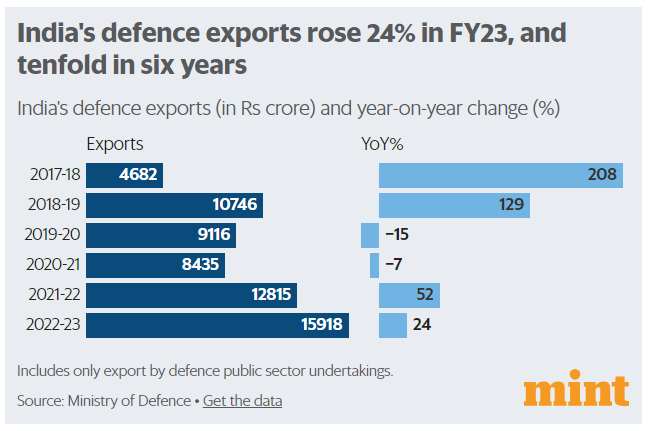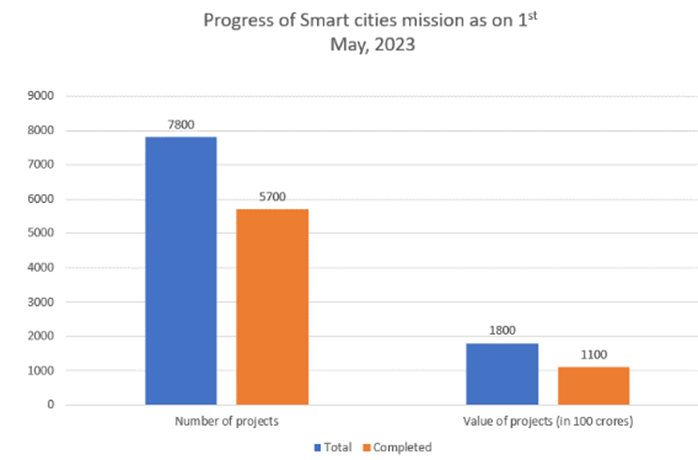In the era of digital advancements, technology continues to be the main driver shaping the world, leading to unprecedented changes in workplaces and homes. The pandemic has significantly impacted the adoption of emerging technologies across various industries, thanks to government policies and initiatives like Aatmanirbhar Bharat and Digital India. This blog will delve into the effects of adopting cutting-edge technologies on crucial sectors like Defence, Space, Smart Cities, Transport, manufacturing, and agriculture from the Indian government and PSU perspective and how it influences India’s economic development. These changes are propelling India towards establishing itself as a unique identity and a global hub in the post-COVID-19 world.
FY2022 has been an exceptional year for India’s technology industry, achieving a record 15.5 percent growth and reaching a revenue of US$227 billion. This success owes much to the winning combination of digital solutions and innovation. The Aatmanirbhar Bharat Abhiyan has significantly impacted the adoption of emerging technologies in the Government & PSUs. The blog highlights the various use cases of adopting cutting-edge technologies on key industries like Defence, Space, Smart Cities, and agriculture from the Indian government and PSU perspective and how it influences India’s economic development.
Aatmanirbharta in Defence
Aatmanirbharta in Defence sector has gained momentum due to the Union Budget 2022–23. The domestic Defence Industry has been allocated about 70% of the Defence budget. Contracts of Rs. 54,000 crores have been signed for domestic procurement. In FY 2022–23, India’s defence exports totaled Rs. 15,918 crores, a 24% increase from last year, and the government aims to achieve an export target of Rs. 35000 crores by 2025.
Use cases of Aatmanirbharbharta in Defence:
- Defense forces are using the BCIDM (Blockchain-based Identity Management) solution to collaborate and share information with each other after the verification of their identities.
- The Indian Army uses an AI-based system called Proactive Real-time Intelligence and Surveillance Monitoring System (PRISM), which can generate real-time audio/visual alerts whenever it detects suspicious enemy movements from multiple surveillance inputs.

Source: Value of Defence Exports ( Rs Cr)
Creating Aatmanirbhar Cities
By integrating cutting-edge technologies, smart cities aim to optimize resource utilization, streamline services, and create a more connected and efficient urban ecosystem. These cities leverage digital technologies like IoT-enabled smart infrastructure, smart grids, intelligent transportation, and efficient waste management to enhance the quality of life, promote sustainable development, and improve overall urban governance.
Source:ICmai
Use cases of Aatmanirbhar Cities:
- Kerala and Karnataka’s police departments are using an Automated fingerprint identification system to identify perpetrators of crime quickly.
- Adopting the Intelligent Transport System (ITS) by the Mysore administration has led to a 50% reduction in fatal accidents, increased punctuality in the operation of state buses to 90%, and less than 10 minutes of waiting time for passengers at the bus stations.

Source: Press Information Bureau
Aatmanirbharta in Defending Space
AI, IoT and blockchain are transformative technologies with the potential to revolutionize the defence space sector by increasing efficiency and safety. As the Indian government aims to modernize the aerospace industry and encourage innovation by launching Mission DefSpace with 75 problem statements, these technologies will play a crucial role in achieving these goals and encourage indigenous design, development and manufacture of defence equipment.
Use cases of Defending Space:
- IoT devices coupled with satellite systems generate humungous amounts of data. India is leveraging IoT and predictive analytics to further process and glean valuable insights from this data. This is believed to play a significant part in augmenting scientific research and decision-making processes.
- ISRO has created a machine learning model that checks the imagery, detects small-scale deforestation, and improves the reporting frequency.
- AIML-based analytics for EO imagery to provide change detection.
- Deploying quantum encryption and replacing traditional cryptography in satellite communication is the need of the hour.
India is making serious inroads in space exploration, which has opened up new opportunities in interplanetary missions. These missions have the potential to boost the nation’s economy, promote further technological advancements, and do path-breaking scientific research, especially in fields such as satellite communication systems, artificial intelligence (AI), and communication robots.
Digitalisation of Agriculture in India
In recent years, digitalization has emerged as a transformative force, revolutionizing the agricultural landscape in India. The integration of technology into the agricultural sector has the potential to enhance productivity, improve efficiency, reduce wastage, and empower farmers with valuable information and tools.
According to the NITI Ayog research on artificial intelligence, agriculture must expand at a rate of 4 percent or higher to maintain an annual growth rate of 8–10 percent. AI in agriculture would be worth $ 2.6 Bn and rise at a pace of 22.5 percent Compound Annual Growth Rate (CAGR) by 2025.
Use Cases of Aatmanirbhar Bharat in Agriculture:
- IIT Ropar-Technology, together with Innovation Foundation, are working towards including IoT-based devices and sensors to enhance saffron production and supply all over India.
- Agriculture extensively uses drones to generate real-time field maps, monitor crop status, and provide data-driven decision support for precise applications. According to a recent study, the global drone market within the agricultural sector would grow at a CAGR of 35.9% and be worth USD 5.7 billion by 2025
India’s Advancements in IT
The field of Information Technology (IT) has been continuously progressing through three timeless aspects: people, processes, and technology. These three aspects drive IT towards specific unified objectives: simplicity, intelligence, and abundance. India’s current digital transformation adoption landscape has been rapidly evolving, with the spending projected to scale to USD 23.6 billion in 2025 at a CAGR of 17%. India is currently embracing emerging technology trends with broad and impactful use cases, surpassing many other parts of the world.
- The country leads in digital payments with the Unified Payments Interface (UPI) network, which has taken over other forms of transactions in terms of volume. India also excels in providing affordable banking through inter-bank and direct-cash transfer schemes.
- The Indian government is developing open-source, indigenous standardization software in collaboration with technology partners. This application aims to facilitate messaging communication within government bodies, defence units without compromising privacy concerns and security.
- Aatmanirbhar Bharat Abhiyan has pushed the growth of industries, including MSMEs/Start-ups in defence sector. The government has taken several policy initiatives in the past three years and ushered reforms to encourage indigenous design, development, and manufacture of defence equipment by Indian Industry. Promotion under various schemes like Innovation for Defence Excellence (iDEX) and Technical Development Fund (TDF) are encouraging participation of MSMEs/start-ups in the development of Defence Products.
- India has made significant strides in a broad range of technology and application areas that are helmed by organizations like ISRO (Indian Space Research Organization), especially in areas that include telecommunications, computer systems (including hardware and software), electronics, optics, and optoelectronics.
- India’s space program has been the most significant recognition of Aatmanirbhar Bharat Abhiyan. More than 60 private companies are leading in the country’s space sectors with advanced preparation, and space tech is about to become the basis of a significant revolution in the 21st century.
Recent technological advancements have reshaped how public sector companies and government agencies function, leading to more efficient, transparent, and citizen-centric services. Forward-thinking organizations are challenging traditional practices, working smarter, and focusing on driving innovation within their structures and across their tech ecosystems. We believe in witnessing tremendous business opportunities in automation, wireless technologies, AI/ML, Big Data, blockchain, distributed architecture, Internet of Things (IoT), and other areas. By continuing to innovate and adopt cutting-edge technologies, the public sector can further strengthen its impact and contribute to the growth and well-being of the nation.
(Note: Aatmanirbhar is derived from 2 Sanskrit words, Aatma – Self, Nirbhar – Support. Together they mean Self Reliant)

 Product Engineering Services Customized software development services for diverse domains
Product Engineering Services Customized software development services for diverse domains
 Sustenance Engineering Going beyond maintenance to prolong life of mature products
Sustenance Engineering Going beyond maintenance to prolong life of mature products
 Managed Services Achieve scalability, operational efficiency and business continuity
Managed Services Achieve scalability, operational efficiency and business continuity
 Technology Consulting & Architecture Leverage the extensive knowledge of our Domain Experts
Technology Consulting & Architecture Leverage the extensive knowledge of our Domain Experts
























